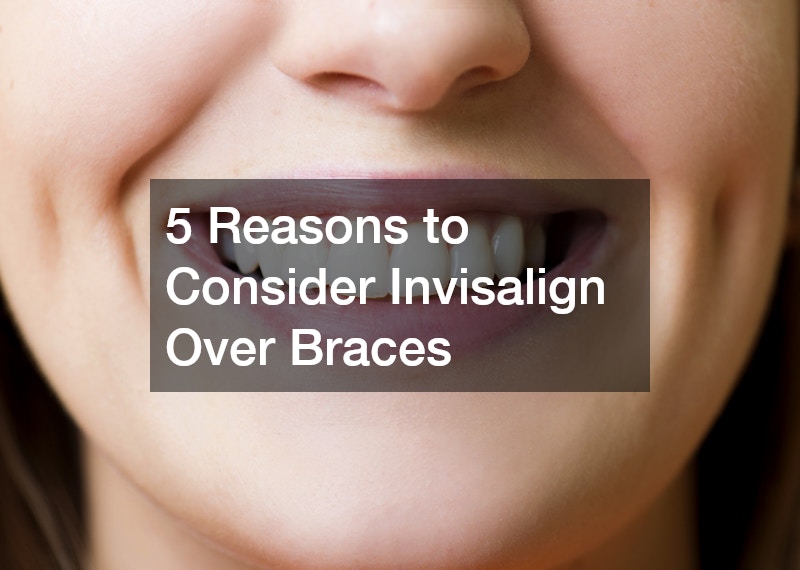
When it comes to straightening teeth, many people immediately envision traditional metal braces. However, orthodontic advancements have introduced alternatives such as Invisalign, offering a modern twist to the age-old solution of achieving a perfect smile. Invisalign, with its clear aligners and nearly invisible appearance, has gained popularity among patients for several compelling reasons. This article delves into five significant reasons to consider Invisalign over traditional braces, providing insight and information for those who are weighing their orthodontic options.
If you’re on the fence about which route to take, keep reading to discover why Invisalign might be the ideal choice for you.
1. Aesthetic Appeal
One of the most appealing aspects of Invisalign is its aesthetic superiority over traditional braces. Invisalign aligners are made from transparent plastic, making them virtually invisible when worn. This is particularly beneficial for adults and teenagers who may feel self-conscious about undergoing orthodontic treatment. The ability to maintain a natural smile throughout treatment is a significant factor for many individuals. Unlike metal braces, which can draw unwanted attention, Invisalign offers a subtle solution that allows patients to straighten their teeth discreetly.
People often shy away from braces due to the metal brackets and wires that are hard to hide. Invisalign aligners eliminate this issue with their sleek and slim design. This feature makes Invisalign an excellent choice for those in professional settings or situations where appearance matters. Moreover, the clear look of Invisalign aligners means you can confidently meet new people or attend social gatherings without feeling insecure. The transparent aligners blend seamlessly with your natural teeth, ensuring that the focus remains on your radiant smile rather than the orthodontic process.
2. Comfort and Convenience
Comfort is another compelling reason to choose Invisalign over traditional braces. Traditional metal braces involve wires, brackets, and bands that can cause irritation to the mouth and gums. In contrast, Invisalign aligners are smooth and made of plastic, reducing the likelihood of discomfort and soreness. This is especially advantageous for patients who might have sensitivities or oral conditions that exacerbate with metal components. The aligners are custom-made for each individual, ensuring a snug fit that enhances both comfort and effectiveness.
The convenience of Invisalign is not limited to comfort alone. Invisalign aligners are removable, which frees wearers from the dietary restrictions often associated with metal braces. Patients can easily take out their aligners for meals and maintain their usual oral hygiene routine without the hassle of threading floss around brackets and wires. This flexibility makes it easier to avoid the risk of food getting stuck in appliances, contributing to better oral health throughout the treatment process. As a result, patients often report a more pleasant and manageable orthodontic experience with Invisalign.
3. Shorter Treatment Time
Many patients are drawn to Invisalign because it can offer a shorter treatment time compared to traditional braces. On average, Invisalign treatment can range from 12 to 18 months, whereas braces may take up to three years, depending on the individual case. This expedited timeline is possible because Invisalign aligners exert consistent pressure to reposition teeth incrementally. Patients receive new sets of aligners every one to two weeks, each set predesigned to guide their teeth a bit closer to their desired positions. This method ensures continuous progress, maximizing efficiency.
An essential factor contributing to the reduced duration is the meticulous planning involved in creating each sequence of aligners. Orthodontists use advanced technology and imaging software to predict and map out the movement of teeth across the treatment span. This precision eliminates much of the trial-and-error associated with adjusting traditional braces. Additionally, because the aligners are removable, patients can manage their schedules around daily wear time, adhering to the treatment plan effectively. This self-discipline can significantly impact the speed of results and the overall success of the treatment.
4. Improved Oral Hygiene
Achieving and maintaining good oral hygiene is simpler with Invisalign compared to traditional braces. With braces, the challenge lies in brushing and flossing effectively around wires and brackets. Removing Invisalign aligners makes daily oral care straightforward, reducing the risk of plaque buildup and tooth decay. Patients can follow their usual brushing and flossing routines without adjusting their techniques significantly. This ease of maintenance ensures that teeth remain healthy throughout the duration of the treatment.
Beyond ease of cleaning, Invisalign promotes better dental health by minimizing the chances of soft tissue injuries. Metal braces often pose the risk of cuts or abrasions to the inside of the cheeks, lips, or gums. Invisalign’s smooth plastic surface avoids such complications, maintaining the integrity of the oral environment. Less irritation means less inflammation, promoting overall oral health. This aspect is especially crucial for individuals with sensitive gums or those who are prone to ulcers and sores from orthodontic appliances.
5. Technological Advancements
The state-of-the-art technology behind Invisalign plays a crucial role in its effectiveness and appeal. Invisalign treatments begin with digital scans and 3D imaging to create a precise model of the patient’s mouth. This advanced technology allows for accurate predictions of tooth movement, providing a clear picture of the planned outcome. Patients are often able to view a digital simulation of their expected results before committing to the treatment. This visualization helps in setting realistic expectations and fosters greater patient satisfaction.
The precision afforded by digital technology extends to the manufacturing of the aligners themselves. Each set of aligners is individually crafted using advanced computer-aided design, ensuring optimal fit and performance. This precision is a definitive advantage over traditional braces, which require manual adjustments and carry a higher likelihood of human error. Invisalign’s reliance on cutting-edge technology underscores its commitment to innovation and patient-centered care. The aligners are crafted to exert exactly the right amount of pressure at the right time, promoting efficient tooth movement.
.

